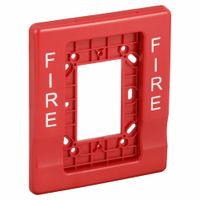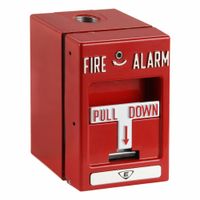Call +(254) 703 030 000 / 751 483 999 / 721 704 777
- Home
- Safety
- Fire Protection
- Facility Fire Alarm Systems
.....Read More
Frequently Asked Questions
What are the main components of a facility fire alarm system?
A facility fire alarm system is composed of several key components that work together to detect and alert occupants of a fire. These components include:
1. **Fire Alarm Control Panel (FACP):** The central hub of the system, it monitors inputs and controls outputs. It processes signals from detection devices and triggers alarms.
2. **Initiating Devices:** These devices detect signs of fire and send signals to the FACP. They include:
- **Smoke Detectors:** Detect smoke particles in the air.
- **Heat Detectors:** Respond to a rapid increase in temperature or a fixed temperature threshold.
- **Manual Pull Stations:** Allow occupants to manually trigger the alarm.
3. **Notification Appliances:** Devices that alert building occupants of a fire. They include:
- **Audible Alarms:** Sirens or bells that emit loud sounds.
- **Visual Alarms:** Strobe lights or flashing lights for the hearing impaired.
- **Voice Evacuation Systems:** Provide verbal instructions during an emergency.
4. **Power Supply:** Ensures the system remains operational. It includes:
- **Primary Power Supply:** Usually connected to the building's main electrical system.
- **Backup Power Supply:** Batteries or generators that provide power during outages.
5. **Communication Systems:** Facilitate communication with emergency services and building management. They include:
- **Fire Alarm Communicator:** Sends signals to a monitoring center or fire department.
- **Intercom Systems:** Allow communication between different areas of the building.
6. **Auxiliary Devices:** Enhance system functionality. They include:
- **Door Holders:** Release doors to close and contain fire.
- **Elevator Controls:** Return elevators to a safe floor and disable them during a fire.
These components work in unison to ensure early detection, effective communication, and prompt evacuation during a fire emergency.
How do fire alarm control panels work?
A fire alarm control panel (FACP) is the central hub of a fire alarm system, responsible for monitoring and managing the system's components. It operates by receiving signals from various input devices like smoke detectors, heat detectors, and manual pull stations. When these devices detect signs of fire, they send an alert to the FACP.
The FACP processes these signals and determines the appropriate response. It can activate output devices such as alarms, sirens, and strobe lights to alert occupants of the building. Additionally, it may trigger other systems like emergency lighting, elevator recall, and fire suppression systems.
FACPs are equipped with a user interface, often including a display screen and control buttons, allowing users to interact with the system. This interface provides information on the system's status, including any active alarms, faults, or maintenance needs. Users can also silence alarms, reset the system, or perform system tests through this interface.
There are two main types of FACPs: conventional and addressable. Conventional panels divide the building into zones, with each zone connected to a set of detectors. When an alarm is triggered, the panel indicates the zone but not the specific device. Addressable panels, on the other hand, assign a unique address to each device, allowing the panel to pinpoint the exact location of the alarm.
FACPs are powered by the building's electrical system but also have backup batteries to ensure functionality during power outages. Regular maintenance and testing are crucial to ensure the system operates effectively in an emergency.
What types of sensors are used in fire alarm systems?
Fire alarm systems typically use the following types of sensors:
1. **Smoke Detectors**:
- **Ionization Smoke Detectors**: These detect smoke using a small amount of radioactive material that ionizes the air, creating a current. When smoke enters the chamber, it disrupts the current, triggering the alarm.
- **Photoelectric Smoke Detectors**: These use a light source and a light sensor. Smoke particles scatter the light beam, causing it to hit the sensor and trigger the alarm.
2. **Heat Detectors**:
- **Fixed Temperature Heat Detectors**: These activate when the temperature reaches a predetermined level.
- **Rate-of-Rise Heat Detectors**: These detect a rapid increase in temperature, triggering the alarm before the fixed temperature is reached.
3. **Flame Detectors**:
- **Ultraviolet (UV) Flame Detectors**: These detect the UV radiation emitted by flames.
- **Infrared (IR) Flame Detectors**: These sense the IR radiation from flames.
- **UV/IR Flame Detectors**: These combine both UV and IR sensors for more accurate detection.
4. **Gas Detectors**:
- These sensors detect the presence of combustible gases like carbon monoxide (CO) or other flammable gases that may indicate a fire.
5. **Multi-Sensor Detectors**:
- These combine multiple types of sensors, such as smoke, heat, and gas, to improve detection accuracy and reduce false alarms.
6. **Aspirating Smoke Detectors (ASD)**:
- These systems actively draw air through a network of pipes to detect smoke particles at an early stage.
7. **Carbon Monoxide Detectors**:
- These detect the presence of CO gas, which can be a byproduct of combustion and an indicator of fire.
Each type of sensor is chosen based on the specific requirements and environment of the area being monitored.
How do fire alarms and strobes alert personnel?
Fire alarms and strobes are critical components of a building's fire safety system, designed to alert occupants to the presence of a fire and facilitate a safe evacuation.
Fire alarms typically consist of audible devices such as bells, horns, or sirens. These devices emit loud, distinct sounds that are easily recognizable and designed to penetrate through ambient noise, ensuring that all occupants are alerted to the emergency. The sound patterns are often continuous or intermittent, depending on the system design and local regulations, to convey urgency and prompt immediate action.
Strobes, on the other hand, are visual alert devices that emit bright, flashing lights. They are particularly important for alerting individuals who are deaf or hard of hearing, ensuring that everyone, regardless of auditory ability, is aware of the emergency. The strobe lights are usually white or clear and flash at a frequency that is noticeable without causing disorientation or discomfort.
Together, fire alarms and strobes provide a multi-sensory alert system that maximizes the likelihood of reaching all building occupants. This dual approach is crucial in diverse environments where individuals may have varying sensory abilities or may be engaged in activities that limit their awareness of auditory or visual cues alone.
In addition to alerting occupants, modern fire alarm systems are often integrated with building management systems to automatically notify emergency services, activate fire suppression systems, and control building ventilation to prevent the spread of smoke. This comprehensive approach ensures a rapid and coordinated response to fire emergencies, enhancing the safety and protection of both people and property.
What is the role of diagnostic and networking components in fire alarm systems?
Diagnostic and networking components play crucial roles in the functionality and efficiency of fire alarm systems.
Diagnostic components are integral for ensuring the reliability and operational readiness of fire alarm systems. They continuously monitor the system's health, identifying faults or malfunctions in real-time. This includes checking the status of detectors, control panels, and communication lines. Diagnostics can detect issues such as sensor failures, wiring problems, or power supply interruptions, allowing for prompt maintenance and reducing the risk of system failure during an emergency. Advanced diagnostic tools can also predict potential failures by analyzing trends and patterns, enabling preemptive maintenance and ensuring the system remains in optimal condition.
Networking components facilitate communication within the fire alarm system and with external systems. They connect various devices, such as smoke detectors, heat sensors, and control panels, allowing them to work cohesively. Networking enables centralized monitoring and control, where all data is collected and analyzed at a central point, often a control room. This integration allows for quicker response times, as alerts and notifications can be sent instantly to relevant personnel or emergency services. Networking also supports scalability, allowing systems to expand as needed without significant overhauls.
Furthermore, networking components enable remote access and management, allowing facility managers to monitor and control the system from off-site locations. This is particularly beneficial for large or multi-site facilities, where centralized oversight is necessary. Networking also supports integration with other building management systems, enhancing overall safety and operational efficiency.
In summary, diagnostic components ensure the system's reliability and readiness, while networking components enhance communication, control, and integration, making fire alarm systems more effective and responsive.
How do power components ensure reliability during power outages?
Power components ensure reliability during power outages through several mechanisms:
1. **Uninterruptible Power Supplies (UPS):** These devices provide immediate backup power from batteries, ensuring that critical systems remain operational during short-term outages. They also offer protection against power surges and voltage fluctuations.
2. **Generators:** Standby generators automatically activate during power outages, supplying electricity to essential systems. They are typically powered by diesel, natural gas, or propane and can run for extended periods, depending on fuel availability.
3. **Automatic Transfer Switches (ATS):** These switches automatically transfer the power supply from the main grid to backup generators or other power sources during an outage, ensuring a seamless transition and minimizing downtime.
4. **Energy Storage Systems:** Advanced battery storage systems, such as lithium-ion batteries, store excess energy generated from renewable sources or the grid. During outages, they release stored energy to maintain power supply continuity.
5. **Microgrids:** These localized grids can operate independently from the main grid during outages. They integrate various power sources, including renewable energy, to provide reliable power to specific areas or facilities.
6. **Redundancy and Load Balancing:** Critical systems often have redundant power components, such as multiple power lines or transformers, to ensure continuous operation if one component fails. Load balancing distributes power evenly across systems to prevent overloads and ensure stability.
7. **Smart Grid Technology:** Advanced grid management systems use real-time data and automation to quickly detect and isolate faults, reroute power, and restore service more efficiently during outages.
8. **Preventive Maintenance and Monitoring:** Regular maintenance and real-time monitoring of power components help identify potential issues before they lead to failures, ensuring systems are always ready to handle outages.
These components and strategies collectively enhance the resilience and reliability of power systems during outages, minimizing disruptions and maintaining essential services.
What are the best practices for maintaining and testing fire alarm systems?
1. **Regular Inspections**: Conduct visual inspections monthly to check for any obvious signs of damage or obstruction. Ensure that all components, including detectors, alarms, and control panels, are in good condition.
2. **Scheduled Testing**: Perform functional testing of the fire alarm system at least twice a year. This includes testing smoke detectors, heat detectors, manual call points, and alarm sounders to ensure they activate correctly.
3. **Battery Checks**: Test backup batteries monthly to ensure they are fully charged and replace them annually or as recommended by the manufacturer.
4. **Professional Servicing**: Engage certified professionals for annual maintenance and servicing. They can perform in-depth checks, calibrate sensors, and update system software if necessary.
5. **Documentation**: Keep detailed records of all inspections, tests, and maintenance activities. This documentation is crucial for compliance with local fire safety regulations and can be useful in case of an incident.
6. **Training**: Train staff and occupants on the fire alarm system's operation, including how to respond to alarms and how to perform basic checks.
7. **System Upgrades**: Regularly review the system's performance and consider upgrades to newer technology if the current system is outdated or if building modifications have been made.
8. **Compliance with Standards**: Ensure that the fire alarm system complies with local fire safety codes and standards, such as NFPA 72 in the United States or BS 5839 in the UK.
9. **Integration with Other Systems**: Ensure the fire alarm system is integrated with other safety systems, such as sprinklers and emergency lighting, for coordinated response during an emergency.
10. **Emergency Drills**: Conduct regular fire drills to test the system's effectiveness and ensure that all building occupants are familiar with evacuation procedures.






